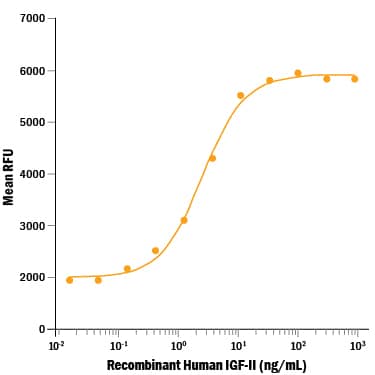Recombinant Human IGF-II/IGF2 Protein, CF Best Seller
R&D Systems, part of Bio-Techne | Catalog # 292-G2

Key Product Details
Product Specifications
Source
Ala25-Glu91
Purity
Endotoxin Level
N-terminal Sequence Analysis
Predicted Molecular Mass
Activity
The ED50 for this effect is 1.5-6 ng/mL.
Reviewed Applications
Read 1 review rated 5 using 292-G2 in the following applications:
Scientific Data Images for Recombinant Human IGF-II/IGF2 Protein, CF
Recombinant Human IGF-II/IGF2 Protein Bioactivity
Recombinant Human IGF-II/IGF2 (Catalog # 292‑G2) stimulates cell proliferation in the MCF-7 human breast cancer cell line. The ED50 for this effect is 1.5‑6 ng/mL.Recombinant Human IGF-II/IGF2 Protein SDS-PAGE
1 μg/lane of Recombinant Human IGF-II/IGF2 was resolved with SDS-PAGE under reducing (R) conditions and visualized by silver staining, showing a single band at 7 kDa.Formulation, Preparation and Storage
292-G2
| Formulation | Lyophilized from a 0.2 μm filtered solution in Acetic Acid. |
| Reconstitution |
Reconstitute at 100 μg/mL in sterile PBS.
|
| Shipping | The product is shipped at ambient temperature. Upon receipt, store it immediately at the temperature recommended below. |
| Stability & Storage | Use a manual defrost freezer and avoid repeated freeze-thaw cycles.
|
Background: IGF-II/IGF2
Insulin-like growth factor I (also known as somatomedin C and somatomedin A) and insulin-like growth factor II (multiplication stimulating activity or MSA) belong to the family of insulin-like growth factors that are structurally homologous to proinsulin. Mature IGF-I and IGF-II share approximately 70% sequence identity. Both IGF-I and IGF-II are expressed in many tissues and cell types and may have autocrine, paracrine and endocrine functions. Mature IGF-I and IGF-II are highly conserved (100% identity between human, bovine and porcine proteins) and exhibit cross-species activity.
IGF-II is a potent mitogenic growth factor. However, unlike IGF-I which has important postnatal roles, the growth-promoting function of IGF-II is limited to embryonic development.
Two specific cell surface receptors that bind IGF-I and IGF-II have been identified. The type I IGF receptor that participates in IGF signaling is structurally related to the insulin receptor. It is a disulfide-linked heterotetrameric transmembrane glycoprotein with an intracellular tyrosine kinase domain. Type I IGF receptor binds IGF-I with higher affinity than IGF-II. The type II IGF receptor which binds IGF-II with much higher affinity than IGF-I is also the cation-independent mannose 6-phosphate receptor. At the present time, it is not known if the type II IGF receptor participates in the IGF signaling pathway. An additional unknown receptor which mediates IGF-II signaling has also been proposed. Circulating IGFs exist in complexes bound to IGF binding proteins. Currently, at least six high affinity binding proteins have been identified.
Long Name
Alternate Names
Gene Symbol
UniProt
Additional IGF-II/IGF2 Products
Product Documents for Recombinant Human IGF-II/IGF2 Protein, CF
Product Specific Notices for Recombinant Human IGF-II/IGF2 Protein, CF
For research use only

